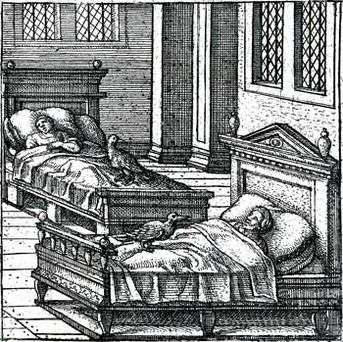Caladrius
The caladrius, according to Roman mythology, is a snow-white bird that lives in the king's house. It is said to be able to take the sickness into itself and then fly away, dispersing the sickness and healing both itself and the sick person. The caladrius legend formed part of medieval bestiary materials, which typically provided a Christian moralization for the animals they discussed.

Origin
It has been theorized that the caladrius is based on a real bird. Due to descriptions of it being completely white with no black on it, it is possible that it was based on the dove, or possibly some sort of water bird such as the heron. Louis Reau believes it was most likely a white plover.[1]
In medieval bestiaries
Medieval interpretations focused on the diagnostic potential of the bird: if it looks into the face of a sick person, the person will live; if it looks away, the person will die.[2] This is compatible with the idea that the caladrius' look draws the sickness into itself; the bird is then said to fly up to the sun, where the disease is burned up and destroyed. In the Christian moralization, the caladrius represents Christ, who is pure white without a trace of the blackness of sin.[3] The bird shows how Christ turns away from unrepentant sinners and casts them off; but those to whom he turns his face, he makes whole again. Sometimes this moral is used specifically against the Jews to describe how, because the Jews did not believe, Christ turned his face from them and toward the Gentiles, taking away and carrying their sins to the cross.[4]
In popular culture
In the Saturday Night Live sketch, "Theodoric of York, Medieval Barber", the title character (played by Steve Martin), uses a caladrius (portrayed by a live bird, most likely some form of dove or pigeon) in an attempt to diagnose a patient. The difficulties of using live animals on live television provided most of the humor for the few seconds of the bird's appearance.
In Age of Mythology: The Titans, a myth unit available to the Atlanteans was the "Caladria," which served as a flying scout and a healer, though it more closely resembled an angel than a bird.
A song dedicated to the Caladrius ("Pasărea Calandrinon") appears on the album "Cantafabule", released in 1975 by Romanian rock group Transsylvania Phoenix.
A Japanese WebNovel titled "Kaifuku Jutsushi no Yarinaoshi ~ Sokushi Mahou to Skill Copy no Choetsu Heal" or "The Redo of a Healing Magician ~ Transcendental Healing of Instant Death Magic and Skill Copying" mentions it as a monster which is considered a God by a demon race tribe. It has the power to devour diseases and also spread them.
In Hollow Earth (2012), by John and Carole Barrowman, the first book of the Hollow Earth Trilogy, the caladrius is a mythical bird that can see the future.
References
- Louis Réau, Iconographie de l'art chrétien, 6 vols. (Paris, 1955-59).
- For a thorough interpretation of the emphasis on diagnostic power, see Herbert L. Kessler, 'Christ the Magic Dragon' Gesta Vol. 48, No. 2, Making Thoughts, Making Pictures, Making Memories: A SPECIAL ISSUE IN HONOR OF MARY J. CARRUTHERS (2009), pp.119-134.
- Ron Baxter, Bestiaries and Their Users in the Middle Ages (Thrupp, 1998), pp.66-68.
- See Kessler, 'Christ the Magic Dragon', p.119.
Further reading
- Druce, George C. "The Caladrius and its legend, sculptured upon the twelfth-century doorway of Alne Church, Yorkshire" Archaeological Journal, 69, 1912, pp. 381-416
External links
- The Caladrius at the Medieval Bestiary
- Images of the Caladrius
- Caladrius at the Aberdeen Bestiary
- Another Page about the Caladrius